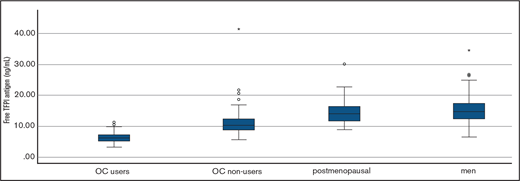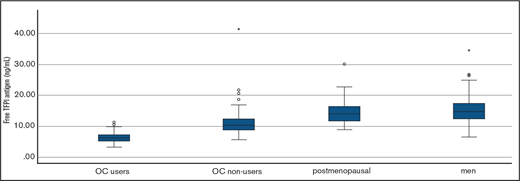TO THE EDITOR:
We read with great interest the article by Mehic et al about the levels of tissue factor pathway inhibitor α (TFPIα) in patients with mild to moderate bleeding tendency.1 The authors investigated 620 patients with mild or moderate bleeding tendency and compared them with 100 sex- and age-matched healthy controls. They concluded that TFPIα levels were higher in the patients than in the controls (median [interquartile range], 8.2 ng/mL [5.5-11.7] vs 7.8 ng/mL [4.3-11.1]; P = .026). The percentage of female participants was 81.5% among the patients and 81.0% among the controls. The median age was 40 years (interquartile range, 28-53 years) in the patients and 38 years (interquartile range, 28-50 years) in the controls. The regional ethical committee of southeast Norway and The Leiden University Medical Centre ethics committee approved the 2 studies referred to in this commentary. The studies were conducted in accordance with the Declaration of Helsinki.
We have previously investigated the association between TFPIα and venous thromboembolism and the effect of hormonal state on TFPI levels. We see that there is a risk that Mehic et al may conclude wrongly from their data because they do not account for the hormonal state in the analyses. Using the same assay for TFPIα that they did, we found that the mean level of TFPIα in healthy controls was 6.17 ng/mL in women using estrogen-containing oral contraceptives, 11.0 ng/mL in fertile women not using oral contraceptives, 14.5 ng/mL in postmenopausal women, and 15.0 ng/mL in men (Figure 1).2 These differences in TFPIα levels also translate into a corresponding difference in diluted prothrombin time assay.3 We have also shown that conventional postmenopausal hormone therapy reduces the median levels of TFPIα from 14.5 ng/mL to 10.8 ng/mL.4 Moreover, the difference in TFPIα between premenopausal and postmenopausal women may give the appearance of an effect of age because postmenopausal women are older than premenopausal. The effect of age on TFPI is in fact very weak.2
Levels of TFPIα according to hormonal state. TFPIα in women using oral contraceptives (OC), premenopausal women not using OCs, postmenopausal women, and men.2
Levels of TFPIα according to hormonal state. TFPIα in women using oral contraceptives (OC), premenopausal women not using OCs, postmenopausal women, and men.2
From this information, it is clear that any comparison of TFPI levels between groups of patients or controls needs to consider not only the sex of the participants but also use of oral contraceptives or postmenopausal hormone therapy, and whether the participating women are premenopausal or postmenopausal at the time of blood sampling. Because 81% of the participants in the Mechic et al study are women, and probably about 25% are postmenopausal, there is a risk that the differences found between patients and controls in TFPIα are caused by differences in use of oral contraceptives, postmenopausal hormone therapy, or distribution of premenopausal and postmenopausal women. The small age difference between the groups suggests, however, that the distribution of postmenopausal women could be approximately the same. We suggest that users of combined oral contraceptives and postmenopausal hormone therapy be excluded from the analyses, if Mehic et al have the information on hormonal state at the time of blood sampling, because the effect of these drugs on TFPI is unpredictable and therefore not easy to adjust for statistically.
Contribution: A.E.A.D. wrote the first draft of the manuscript; and P.M.S. revised the manuscript.
Conflict-of-interest disclosure: A.E.A.D. has received personal fees from Pfizer AS, Bristol-Myers Squibb, Novartis Norway AS, and Merck Sharp & Dohme. P.M.S. declares no competing financial interests.
Correspondence: Anders Erik Astrup Dahm, Department of Hematology, Akershus University Hospital, Postbox 1000, 1478 Lørenskog, Norway; e-mail: aeadahm@gmail.com.
References
Author notes
For data sharing, contact the corresponding author, Anders Erik Astrup Dahm, at aeadahm@gmail.com.



